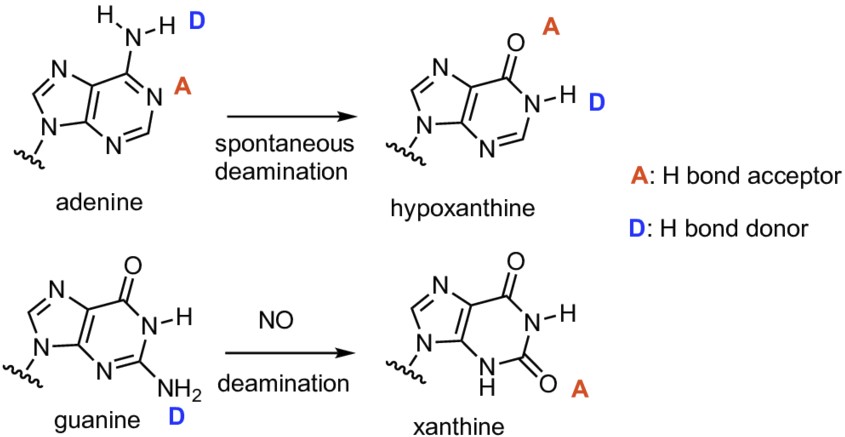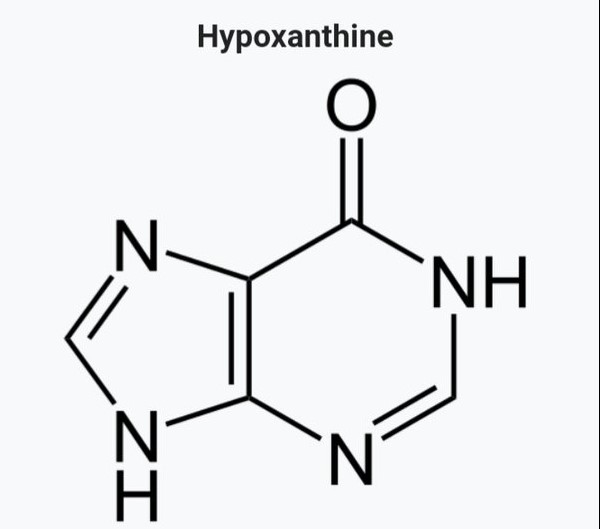Purines, including xanthine and hypoxanthine, are crucial components in the nucleic acid structure, which are fundamental to genetic encoding in organisms. They play pivotal roles not only in DNA and RNA synthesis but also in various biochemical processes. These compounds are central to energy transfer, cellular signaling, and metabolic integration, making them subjects of extensive scientific study and medical interest.
Xanthine and hypoxanthine differ mainly in their molecular structure and role in biological systems. Xanthine is a derivative of hypoxanthine obtained through the oxidation process involving the enzyme xanthine oxidase. Hypoxanthine, on the other hand, is a key intermediate in the degradation of adenine and guanine and is recycled back into nucleotides through the purine salvage pathway.
These substances are not merely intermediates in metabolism; they influence essential physiological functions and have implications in health and disease. Their balance and transformation are critical for cellular health, influencing everything from energy metabolism to the immune response and neurological health.

Chemical Structures
Basic Chemistry of Purines
Purines are a vital class of biomolecules found in every cell of the human body and many other forms of life. They are heterocyclic compounds made up of a pyrimidine ring fused to an imidazole ring. These structures form the basis of adenine, guanine, xanthine, and hypoxanthine, which are essential for constructing DNA and RNA molecules. In addition to their role in genetics, purines are also integral to the synthesis of ATP, GTP, and other critical molecules that fuel cellular activities.
Structural Formula of Xanthine
Xanthine has a molecular structure represented by the formula C₅H₄N₄O₂. It is a derivative of purine, where the oxygen atom is added to the carbon at the 2 position of the purine ring. This structural modification is pivotal as it transforms the biochemical properties and the role of xanthine in biological systems.
Structural Formula of Hypoxanthine
Hypoxanthine, with the chemical formula C₅H₄N₄O, also derives from purine. It differs from xanthine by the absence of an oxygen atom at the 2 position, placing it at an earlier stage in the metabolic pathway of purine degradation. The presence or absence of this oxygen atom is a critical distinction that influences their respective roles in metabolic pathways.
Biosynthesis Pathways
Origin of Xanthine in the Body
Xanthine is primarily formed from the degradation of guanine and adenine in the liver. The pathway involves several enzymatic reactions that convert these nucleotides first into their respective xanthine bases:
- Guanine is deaminated to xanthine by guanine deaminase.
- Adenine is converted to hypoxanthine, which is further oxidized to xanthine by xanthine oxidase.
This sequence of reactions is crucial for the effective recycling and disposal of purines.
Origin of Hypoxanthine in the Body
Hypoxanthine is produced through several pathways in the purine salvage cycle:
- It is directly synthesized by the deamination of adenine.
- It can also be created through the breakdown of IMP (inosine monophosphate) during nucleotide turnover.
These pathways highlight the body’s efficiency in recycling purines to conserve energy and resources.
Enzymatic Reactions Involved
The transformation from adenine or guanine to xanthine and hypoxanthine involves critical enzymes:
- Adenine phosphoribosyltransferase (APRT) directly converts adenine to AMP, which is further broken down.
- Hypoxanthine-guanine phosphoribosyltransferase (HGPRT) facilitates the recycling of hypoxanthine back to IMP.
Understanding these enzymatic steps is essential for diagnosing and treating related metabolic disorders.
Biological Roles
Role of Xanthine in Metabolism
In human metabolism, xanthine serves primarily as a transitional molecule in the pathway to uric acid production, which is excreted from the body. The role of xanthine is critical in conditions where the regulation of uric acid is disrupted, such as in gout or xanthinuria.
Role of Hypoxanthine in Metabolism
Hypoxanthine plays a dual role in cellular metabolism:
- It is a key intermediate in the purine salvage pathway, helping to conserve energy by recycling purines into nucleotides.
- It also acts as a substrate for xanthine oxidase in the pathway that produces uric acid, an end product of purine metabolism.
Comparison of Biological Functions
While both xanthine and hypoxanthine are involved in purine degradation and recycling, their specific roles in these processes vary significantly. This variation influences how cells manage energy and waste products, affecting overall cellular health and function.
Health Implications
Xanthine and Disease
Elevated levels of xanthine can lead to medical conditions such as:
- Xanthinuria: A rare genetic disorder where the lack of xanthine oxidase leads to an accumulation of xanthine, causing kidney stones and renal failure.
- Gout: Although primarily linked to uric acid, disturbances in xanthine levels can also exacerbate this condition.
Hypoxanthine and Disease
Hypoxanthine’s accumulation is associated with several disorders:
- Lesch-Nyhan Syndrome: This genetic disorder, due to a deficiency in HGPRT, leads to high levels of hypoxanthine, causing severe gout and neurological symptoms.
- Hyperuricemia: Elevated hypoxanthine can increase uric acid production, contributing to diseases like gout and kidney stones.
Clinical Significance of Levels in the Body
Monitoring xanthine and hypoxanthine levels is crucial for diagnosing and managing purine metabolism disorders. These measurements can help pinpoint specific enzymatic defects and guide treatment options to manage symptoms effectively.
Medical Applications
Use in Diagnostic Testing
The measurement of xanthine and hypoxanthine levels in biological samples, such as blood and urine, plays a crucial role in the diagnosis of various metabolic and genetic disorders. Diagnostic testing for these compounds involves specific biochemical assays that quantify purine derivatives to help identify abnormalities in purine metabolism:
- High-performance liquid chromatography (HPLC) is commonly used due to its accuracy and reliability.
- Enzymatic assays offer another method by detecting enzyme activity related to purine breakdown.
These tests are essential for diagnosing conditions like xanthinuria and Lesch-Nyhan syndrome, offering insights into the underlying metabolic issues.
Therapeutic Uses of Purine Derivatives
Purine derivatives have significant therapeutic applications, particularly in the treatment of diseases such as leukemia and gout. Medications derived from these compounds include:
- Allopurinol: This drug inhibits xanthine oxidase, reducing the production of uric acid, which is crucial in the treatment of gout.
- Mercaptopurine: A key treatment option for acute lymphoblastic leukemia, it interferes with DNA replication in cancer cells.
These drugs demonstrate the importance of purines in pharmacotherapy, providing critical solutions for managing complex diseases.
Research Areas and Potential Treatments
Ongoing research into xanthine and hypoxanthine is uncovering new therapeutic potentials for these molecules. Current research focuses on:
- Neuroprotective roles: Investigating the antioxidant properties of purines, which may protect against cellular damage in neurodegenerative diseases.
- Anti-inflammatory applications: Exploring how modulating purine metabolism can reduce inflammation in chronic diseases.
These areas highlight the evolving understanding of purine roles in health and disease, suggesting avenues for innovative treatments.
Metabolic Disorders
Disorders Related to Xanthine
Xanthinuria is the most notable disorder involving elevated xanthine levels. It is characterized by:
- Reduced or absent xanthine oxidase activity, leading to the accumulation of xanthine.
- Symptoms such as kidney stones and urinary tract issues due to xanthine crystals.
Understanding these disorders aids in the development of targeted treatment strategies.
Disorders Related to Hypoxanthine
Lesch-Nyhan syndrome is primarily associated with hypoxanthine accumulation. It manifests through:
- Neurological symptoms like aggressive behavior and self-mutilation.
- Physical symptoms including gout and kidney problems.
These symptoms result from a deficiency in HGPRT, an enzyme critical for purine recycling.
Treatment and Management Strategies
Managing disorders related to xanthine and hypoxanthine involves a combination of medication, dietary adjustments, and sometimes surgical interventions:
- Medications: Drugs like allopurinol are used to manage uric acid levels.
- Dietary management: Limiting foods high in purines can help reduce symptoms in affected individuals.
These strategies are tailored to individual needs, ensuring effective management of symptoms.
Pharmacological Aspects
Drugs Targeting Xanthine Pathways
Pharmacological interventions targeting xanthine pathways focus on controlling uric acid production:
- Xanthine oxidase inhibitors such as allopurinol and febuxostat prevent the conversion of hypoxanthine to xanthine and ultimately to uric acid.
- These drugs are essential for treating hyperuricemia and its complications, such as gout and kidney stones.
Drugs Targeting Hypoxanthine Pathways
Therapies targeting hypoxanthine pathways aim to correct enzyme deficiencies or reduce harmful metabolite accumulation:
- Enzyme replacement therapies are being explored to supplement or replace dysfunctional enzymes in disorders like Lesch-Nyhan syndrome.
- Gene therapy: Emerging research is investigating the potential of correcting genetic defects at the DNA level to restore normal enzyme function.
Effects and Side Effects
While drugs targeting xanthine and hypoxanthine pathways are beneficial, they can also cause side effects:
- Allopurinol may cause allergic reactions and, in rare cases, a severe condition known as Stevens-Johnson syndrome.
- Gene therapy carries risks, including immune reactions and potential long-term effects that are still under investigation.
Diagnostic Relevance
Testing for Xanthine Levels
Diagnostic tests for xanthine involve:
- Urine tests: These are the most common method, using chromatographic techniques to detect and quantify xanthine.
- Blood tests: Less frequently used but can provide crucial data for diagnosing metabolic conditions.
Testing for Hypoxanthine Levels
Hypoxanthine levels are typically measured using:
- HPLC methods: Providing accurate and detailed profiles of purine metabolites.
- Spectrophotometric assays: Useful for rapid screening but less precise than HPLC.
Interpretation and Clinical Decisions
Interpreting test results for xanthine and hypoxanthine requires a deep understanding of purine metabolism and its disorders:
- High levels of xanthine may indicate xanthinuria or reduced xanthine oxidase activity.
- Elevated hypoxanthine can signal problems like Lesch-Nyhan syndrome or excessive purine turnover.
Frequently Asked Questions
What are Xanthine and Hypoxanthine?
Xanthine and hypoxanthine are types of purine bases involved in the body’s metabolic processes. While xanthine serves as a precursor to uric acid during purine degradation, hypoxanthine is involved in the synthesis and breakdown of nucleic acids.
How do Xanthine and Hypoxanthine differ chemically?
Chemically, xanthine is an oxidized form of hypoxanthine. The presence of an additional oxygen atom in xanthine differentiates it from hypoxanthine, impacting their respective roles and functions in biological pathways.
What role do Xanthine and Hypoxanthine play in the body?
Both compounds are integral to the purine metabolism pathway. Xanthine is primarily involved in the pathway leading to uric acid production, critical for eliminating excess nitrogen. Hypoxanthine plays a role in the salvage pathways, being reused to form nucleotides necessary for DNA and RNA.
Why are Xanthine and Hypoxanthine important in medicine?
In medicine, the levels of xanthine and hypoxanthine are important diagnostic markers for several diseases, including gout, xanthinuria, and Lesch-Nyhan syndrome. Understanding their concentrations helps in diagnosing and monitoring these conditions effectively.
What are common disorders associated with Xanthine and Hypoxanthine?
Disorders such as xanthinuria involve the excessive accumulation of xanthine due to a deficiency in xanthine oxidase, leading to kidney stones. Similarly, a defect in hypoxanthine-guanine phosphoribosyltransferase can lead to Lesch-Nyhan syndrome, characterized by neurological dysfunction and hyperuricemia.
Conclusion
The comparative study of xanthine and hypoxanthine reveals much about their significant roles in human physiology and their impact on health. As researchers delve deeper into their biochemical pathways, the potential for new therapeutic approaches emerges, highlighting the importance of these compounds beyond their basic metabolic functions.
Future advancements in medical research may further elucidate the complex interactions and mechanisms by which xanthine and hypoxanthine influence diseases and treatments. The ongoing exploration of these purines continues to offer promising avenues for enhancing disease diagnosis, treatment, and overall understanding of human biochemistry.

